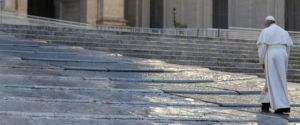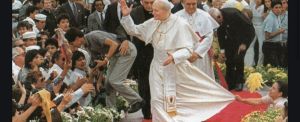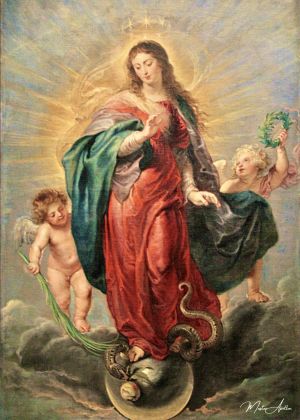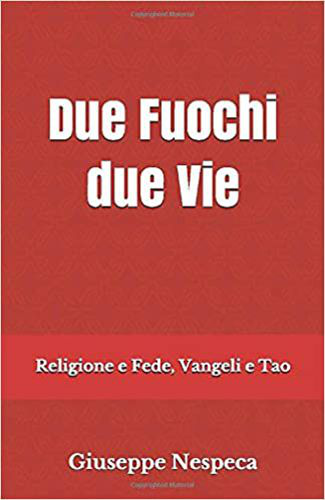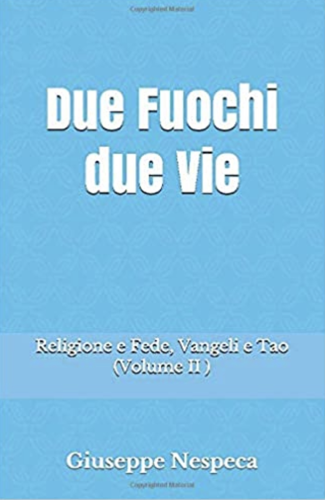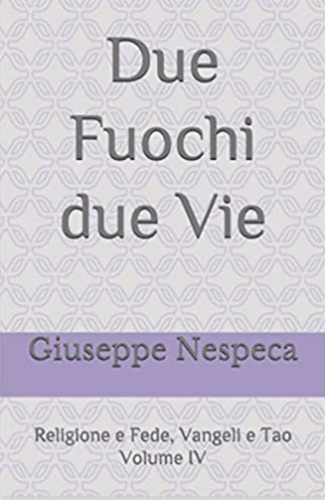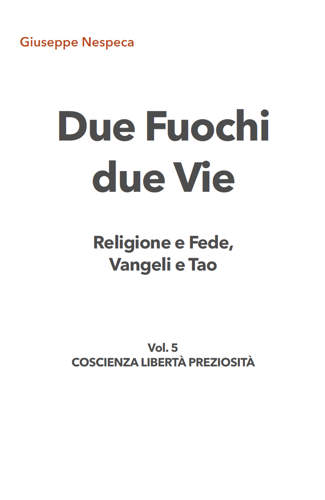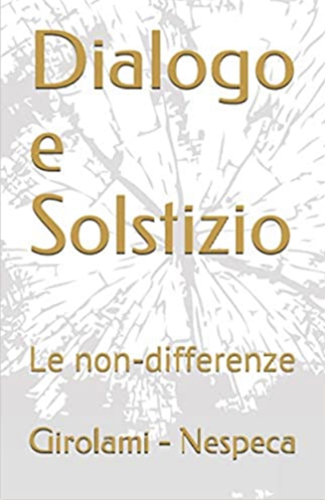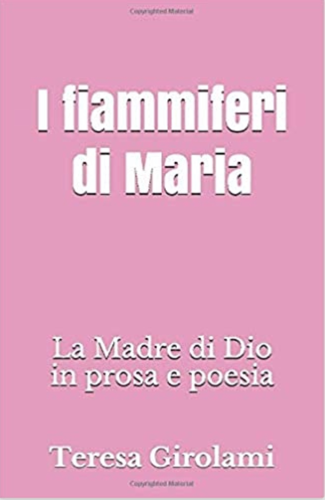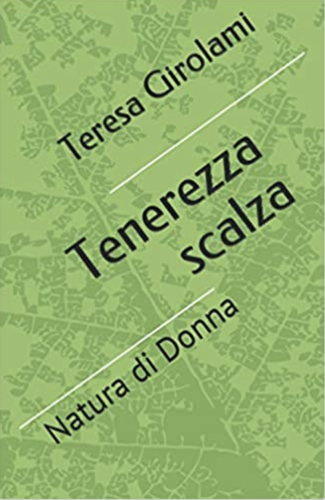
don Giuseppe Nespeca
Giuseppe Nespeca è architetto e sacerdote. Cultore della Sacra scrittura è autore della raccolta "Due Fuochi due Vie - Religione e Fede, Vangeli e Tao"; coautore del libro "Dialogo e Solstizio".
Earth Contact: deviances and Ascent
Casual Incarnation, in tenuousness and density
(Mt 1:1-17)
In the ancient East, genealogies mentioned only men, and it is surprising that Mt mentions the names of no less than five women - considered merely servile, untrustworthy creatures, impure by nature.
But in the story of Mary's four companions there is not a little that is a-normal [also because of the model of life chosen] that is nevertheless worthwhile.
Here we are then challenged by the Gospel on the weight to be given to the rigidity of norms, which in the history of spirituality have often devoured the spontaneous being of those called by the Father (simply to express themselves).
Cultures animated by the Wisdom of Nature also testify to this weight.
The Tao Tê Ching (LVII) writes: "When the world is governed by correction, weapons are used with falsehood [...] That is why the saint says: I do not act and the people transform themselves [...] I do not yearn and the people make themselves simple".
In order to reach the human fullness of the Son, God did not pretend to overcome concrete events, on the contrary He assumed them and valorised them.
The path that leads to Christ is not a matter of climbs, nor of results or performances to be calibrated more and more in a linear crescendo that is therefore moralising and dirigiste (which does not impose turning points that count, nor does it solve the real problems).
Commenting on the Tao(i), Master Ho-shang Kung writes: "Mystery is Heaven. He says that both the man who has desires and the man who has none equally receive ch'ì from Heaven. Within heaven there is another heaven; in the ch'ì there is density and tenuity".
In history, the Eternal One manages to give unfurled wings not so much to strength and genius, but to all the poor beginnings, to the paucity of our nature, which suddenly turns into totally unpredictable wealth.
And if we tear the thread again and again, the Lord knits it back together - not to fix it, patch it up and resume as before, but to make a whole new weave. Precisely from the falls.
It is those moments of the earth-to-earth divide that force humanity to change symbolic direction and not repeat itself, stagnating in the circuit of the usual cerebral and purist perimeters - habitual, and where everything is normal.
As a result of inner crashes and afterthoughts, how many people have fulfilled their destiny by deviating from the marked, quiet, protected and comfortable path (Cottolengo, Mother Teresa, etc.)!
Out of the mire of the swamp sprout beautiful, clean flowers, which do not even resemble those we had ever imagined we could contemplate in the various stages of life.
The tumbles of the protagonists of salvation history did not come from weakness. They were signs of bad or partial use of resources; stimuli to change one's eye, re-evaluate one's point of view and many hopes.
Those collapses configured new challenges: they were interpreted as strong provocations: to shift energies and change track.
The upturns following the downturns turned into new opportunities, not at all unexpected, fully discordant with the ready-made solutions that extinguish characters.
Even our crisis only becomes serious when the failures do not result in new insights and different paths that we had not thought of (perhaps in any of our good intentions).
Strange this link between our abysses and the heights of the Spirit: it is the Incarnation, no theory - all reality.
There is no Gift that resembles the divine top and comes to us without passing through and involving the dimension of finitude.
The holes in the water convey the all-too-human figure of what we are - behind illusions or the very appearances we do not want to put down, to convince ourselves that we are instead identified 'characters'.
But the ambivalences and flaws continue to want to unhinge our gaze and destiny elsewhere, with respect to common expectations [today also the paroxysm of the point in the polls].
Behind the mask and beyond the convictions acquired from environment, manners or procedures... there is the Father's great Secret about us.
It is precisely the descents that spiritualise, through a working of the soul that is rammed by events, so that it turns to acquire new awareness, internalises different evaluations, sees and embraces other varied horizons, even missionary ones.
The crack that knocks down can be more consistent than any progress; not because it initiates asceticism: it becomes contact with the 'earth' - where we find the sap that really corresponds to us, to regenerate.
The fall or even the ruin of a reassuring status has in every happening a propulsive, regenerative, transmutative function; normal, after all, and in which the story of God is totally recognised.
To internalise and live the message:
What were your turning points?
What deviation has fulfilled you?Not only through men, but with them
With today's liturgy we enter the final stretch of the Advent journey, which calls for us to intensify our preparation, in order to celebrate the Lord's Christmas with faith and joy, welcoming with intimate awe God who makes himself close to man, to each one of us.
The first reading presents us with the elderly Jacob gathering his sons for the blessing: it is an event of great intensity and emotion. This blessing is like a seal of fidelity to the covenant with God, but it is also a prophetic vision, looking forward and indicating a mission. Jacob is the father who, through the not always straightforward paths of his own history, comes to the joy of gathering his children around him and plotting the future of each one and their descendants. In particular, today we have heard the reference to the tribe of Judah, whose royal strength is exalted, represented by the lion, as well as to the monarchy of David, represented by the sceptre, the staff of command, which alludes to the coming of the Messiah. Thus, in this dual image, the future mystery of the lion who becomes a lamb, of the king whose staff of command is the cross, the sign of true kingship, transpires. Jacob has gradually become aware of the primacy of God, has understood that his path is guided and sustained by the Lord's faithfulness, and cannot but respond with full adherence to God's covenant and plan of salvation, becoming in turn, together with his own descendants, a link in the divine plan.
The passage in Matthew's Gospel presents us with the "genealogy of Jesus Christ, son of David, son of Abraham" (Mt 1:1), further emphasising and explicating God's faithfulness to the promise, which He fulfils not only through men, but with them and, as with Jacob, sometimes through tortuous and unforeseen ways. The awaited Messiah, the object of the promise, is true God, but also true man; Son of God, but also Son born of the Virgin, Mary of Nazareth, holy flesh of Abraham, in whose seed all the peoples of the earth shall be blessed (cf. Gen 22:18). In this genealogy, besides Mary, four women are mentioned. They are not Sarah, Rebecca, Leah, Rachel, i.e. the great figures of Israel's history. Paradoxically, instead, it is four pagan women: Racab, Ruth, Bathsheba, Tamar, who apparently 'disturb' the purity of a genealogy. But in these pagan women, who appear at decisive points in salvation history, the mystery of the church of the pagans, the universality of salvation, shines through. They are pagan women in whom the future, the universality of salvation, appears. They are also sinful women, and so the mystery of grace also appears in them: it is not our works that redeem the world, but it is the Lord who gives us true life. They are sinful women, yes, in whom appears the greatness of the grace that we all need. Yet these women reveal an exemplary response to God's faithfulness, showing faith in the God of Israel. And so we see the church of the Gentiles, a mystery of grace, faith as a gift and a path to communion with God. Matthew's genealogy, therefore, is not simply the list of generations: it is the history realised primarily by God, but with the response of humanity. It is a genealogy of grace and faith: it is precisely on the absolute faithfulness of God and the solid faith of these women that the continuation of the promise made to Israel rests.
[Pope Benedict, homily at the Aletti Centre, 17 December 2009].
Man, God's surname
Man is God's surname: the Lord in fact takes the name from each one of us - whether we are saints or sinners - to make it his own surname. For in becoming incarnate, the Lord made history with humanity: his joy was to share his life with us, 'and this makes one weep: so much love, so much tenderness'.
It was with thoughts turned to the now imminent Christmas that Pope Francis commented on Tuesday 17 December on the two readings proposed by the liturgy of the word, taken respectively from Genesis (49:2, 8-10) and the Gospel of Matthew (1:1-17). On the day of his 77th birthday, the Holy Father presided over morning Mass as usual in the chapel of Santa Marta. Concelebrating among others was Cardinal Dean Angelo Sodano, who expressed the best wishes of the entire College of Cardinals to him.
In his homily, which focused on the presence of God in the history of humanity, the Bishop of Rome identified two terms - inheritance and genealogy - as the keys to interpreting the first reading (concerning the prophecy of Jacob gathering his sons and predicting a glorious descent for Judah) and the Gospel passage containing the genealogy of Jesus. Focusing in particular on the latter, he emphasised that it is not 'a telephone book', but 'an important subject: it is pure history', because 'God sent his son' among men. And, he added, "Jesus is consubstantial with his father, God; but he is also consubstantial with his mother, a woman. And this is that consubstantiality of the mother: God made himself history, God wanted to make himself history. He is with us. He has made a journey with us'.
A journey,' continued the bishop of Rome, 'that began from afar, in Paradise, immediately after original sin. From that moment, in fact, the Lord 'had this idea: to make a journey with us'. Therefore, "he called Abraham, the first one named in this list, and invited him to walk. And Abraham began that journey: he begat Isaac, and Isaac Jacob, and Jacob Judah". And so on through human history. 'God walks with his people', therefore, because 'he did not want to come to save us without history; he wanted to make history with us'.
A history, said the Pontiff, made of holiness and sin, because in the list of Jesus' genealogy there are saints and sinners. Among the former the Pope recalled "our father Abraham" and "David, who after sin converted". Among the latter, he singled out "high-level sinners, who did big sins", but with whom God equally "made history". Sinners who failed to respond to the plan God had imagined for them: like 'Solomon, so great and intelligent, who ended up as a poor man who did not even know his name'. Yet, Pope Francis noted, God was also with him. "And this is the beauty of it: God makes history with us. Moreover, when God wants to say who he is, he says: I am the God of Abraham, of Isaac, of Jacob".
That is why to the question "what is God's surname?" for Pope Francis it is possible to answer: "It is us, each one of us. He takes the name from us to make it his surname". And in the example offered by the Pontiff there are not only the fathers of our faith, but also ordinary people. "I am the God of Abraham, of Isaac, of Jacob, of Pedro, of Marietta, of Armony, of Marisa, of Simon, of everyone. He takes the surname from us. God's surname is each one of us,' he explained.
Hence the realisation that by taking 'the surname from our name, God has made history with us'; indeed, more than that: 'He has let history be written by us'. And we still continue to write 'this history', which is made 'of grace and sin', while the Lord does not tire of coming after us: 'this is God's humility, God's patience, God's love'. Moreover, even 'the book of Wisdom says that the joy of the Lord is among the children of man, with us'.
So 'as Christmas approaches', it came naturally to Pope Francis - as he himself confided in concluding his reflection - to think: 'If he made his history with us, if he took his last name from us, if he let us write his history', we for our part should let God write ours. Because, he clarified, 'holiness' is precisely 'letting the Lord write our story'. And this is the Christmas wish that the Pontiff wanted to make 'for all of us'. A wish that is an invitation to open our hearts: "Let the Lord write history for you and let you let him write it for you."
[Pope Francis, S. Marta homily, in L'Osservatore Romano 18/12/2013]
Not only through men, but With them
Dear Friends,
With today's Liturgy we enter into the last stage of the Advent journey, which urges us to intensify our preparation, to celebrate the Lord's Birth with faith and joy, welcoming with deep wonder God who makes himself close to human beings, to each one of us.
The First Reading presents to us the aged Jacob who gathers his sons to give them his blessing. It is an event of great intensity and emotion. This blessing is like their seal of fidelity to the Covenant with God; but it is also a prophetic vision that looks ahead and indicates a mission. Jacob is a father who, on the paths of his own history that have not always been straight, achieves the joy of gathering his children round him and predicting the future of each one and of their descendents. Today, in particular, we heard the reference to the tribe of Judah whose royal power is exalted, represented by the lion, as well as the monarchy of David, represented by the sceptre, by the ruler's staff that alludes to the coming of the Messiah. Thus through this duel image, the mysterious future of the lion that becomes a lamb, of the king whose ruler's staff becomes the Cross, is the sign of true kingship. Jacob has gradually become aware of the primacy of God, he has realized that his journey is guided and sustained by the Lord's faithfulness, and cannot but answer with full adherence to God's Covenant and plan of salvation becoming in turn, together with his own descendants, a link in the divine plan.
The Gospel of Matthew presents to us the "genealogy of Jesus Christ, the son of David, the son of Abraham" (Mt 1: 1), underlining and further explaining God's fidelity to the promise that he puts into practice not only through human beings but with them, and, as for Jacob, sometimes in tortuous and unexpected ways. The awaited Messiah, the subject of the promise, is true God but also true man; the Son of God, but also the Son born of the Virgin Mary of Nazareth, the holy flesh of Abraham in whose descendants all the peoples of the earth would be blessed (cf. Gn 22: 18). In this genealogy, in addition to Mary, four other women are recalled. They are not Sarah, Rebecca, Leah, or Rachel, that is, the great figures of the history of Israel. Instead, paradoxically they are four pagan women: Rahab, Ruth, Bathsheba, and Tamar, who seemingly "cloud" the purity of a genealogy. Yet, in these pagan women who appear at crucial points in the history of salvation, also appears the mystery of the church of the pagans, the universality of salvation. They are pagan women in whom appears the future, the universality of salvation. They are also sinful women, and thus the mystery of grace appears in them: it is not our works that redeem the world, but rather the Lord who gives us true life. They are sinful women, yes, in whom appears the greatness of the grace that we all need. Yet these women reveal an exemplary response to God's faithfulness, showing their faith in the God of Israel. And thus we see through the Church of the pagans, the mystery of grace, faith as a gift and as the way to communion with God. Matthew's genealogy, therefore, is not merely a list of generations: it is history brought about first by God, but with humanity's response. It is a genealogy of grace and faith: it is precisely on the absolute fidelity of God and on the sound faith of these women that the fulfilment of the promise made to Israel is founded.
[Pope Benedict, homily at the Aletti Centre, 17 December 2009]
In the Human Family, linking generations, to understand our insertion
Dear Brothers and Sisters,
1. Reflection on the mystery of Jesus, which especially marks this first year of immediate preparation for the Great Jubilee of the Year 2000, goes well with the Christmas holidays. Continuing the meditation I began a few Sundays ago, today I would like to reflect on a title Jesus is given more than once in the Gospels. He is called “son of David”. Matthew’s Gospel opens precisely with these words: “The book of the genealogy of Jesus Christ, the son of David” (Mt 1:1).
We might say that it is a family title. Through Joseph, his putative father, Jesus is linked to the entire human chain which reaches from son to father back to King David. This genealogical relationship emphasizes the concreteness of the Incarnation: by becoming man, the Eternal Word of God fully entered the human family, putting himself in the lineage of a specific family tradition. In this way he also wanted to be one of us, experiencing that unique bond which, linking generations, enables each person to feel rooted not only in time and space, but also in a beneficial fabric of memories and affections.
2. However, in addition to this anthropological meaning, the title “son of David” also has a specific sense which casts light on God’s plan. In fact, it reminds us that the Christian event is the culmination of a salvation history which God has gradually brought about since the Old Testament, offering the Jewish people a special “covenant” and making them the bearer of saving promises which in Jesus of Nazareth would be fulfilled for all humanity. Therefore when his contemporaries call him “son of David”, they are recognizing that the ancient promises are fulfilled in him and proclaim the definitive realization of the messianic hope. Every man and woman can now draw from this hope, making his own the cry which is found on the lips of blind Bartimaeus in the Gospel: “Jesus, son of David, have mercy on me!” (Mk 10:47). By calling on the “son of David”, humanity can rediscover light for the gaze of its heart.
3. May Mary, the humble girl of Nazareth, who in giving birth to the Son of God introduced him into David's genealogy and into the entire human family, help us to grow in our understanding of how we are involved in this history of salvation. Let us be guided by her in the intimacy of her Holy Family where the seed of the new humanity is sown. At the beginning of this new year, may the Blessed Virgin bless all the families of the world, so that in Jesus they may recognize their true Saviour.
[Pope John Paul II, Angelus 5 January 1997]
Man, God's surname
Man is God's surname: the Lord in fact takes the name from each of us - whether we are saints or sinners - to make it his own surname. For in becoming incarnate, the Lord made history with humanity: his joy was to share his life with us, 'and this makes one weep: so much love, so much tenderness'.
It was with thoughts turned to the now imminent Christmas that Pope Francis commented on Tuesday 17 December on the two readings proposed by the liturgy of the word, taken respectively from Genesis (49:2, 8-10) and the Gospel of Matthew (1:1-17). On the day of his 77th birthday, the Holy Father presided over morning Mass as usual in the chapel of Santa Marta. Concelebrating among others was Cardinal Dean Angelo Sodano, who expressed the best wishes of the entire College of Cardinals to him.
In his homily, which focused on the presence of God in the history of humanity, the Bishop of Rome identified two terms - inheritance and genealogy - as the keys to interpreting the first reading (concerning the prophecy of Jacob gathering his sons and predicting a glorious descent for Judah) and the Gospel passage containing the genealogy of Jesus. Focusing in particular on the latter, he emphasised that it is not 'a telephone book', but 'an important subject: it is pure history', because 'God sent his son' among men. And, he added, 'Jesus is consubstantial with his father, God; but he is also consubstantial with his mother, a woman. And this is that consubstantiality of the mother: God made himself history, God wanted to make himself history. He is with us. He has made a journey with us'.
A journey,' continued the bishop of Rome, 'that began from afar, in Paradise, immediately after original sin. From that moment, in fact, the Lord 'had this idea: to make a journey with us'. Therefore, 'he called Abraham, the first one named in this list, and invited him to walk. And Abraham began that journey: he begat Isaac, and Isaac Jacob, and Jacob Judah'. And so on through human history. God walks with his people', therefore, because 'he did not want to come to save us without history; he wanted to make history with us'.
A history, said the Pontiff, made of holiness and sin, because in the list of Jesus' genealogy there are saints and sinners. Among the former the Pope recalled 'our father Abraham' and 'David, who after sin converted'. Among the latter, he singled out "high-level sinners, who did big sins", but with whom God equally "made history". Sinners who failed to respond to the plan God had imagined for them: like 'Solomon, so great and intelligent, who ended up as a poor man who did not even know his name'. Yet, Pope Francis noted, God was also with him. "And this is the beauty of it: God makes history with us. Moreover, when God wants to say who he is, he says: I am the God of Abraham, of Isaac, of Jacob'.
That is why to the question "what is God's surname?" for Pope Francis it is possible to answer: "It is us, each one of us. He takes the name from us to make it his surname'. And in the example offered by the Pontiff there are not only the fathers of our faith, but also ordinary people. "I am the God of Abraham, of Isaac, of Jacob, of Pedro, of Marietta, of Armony, of Marisa, of Simon, of everyone. He takes the surname from us. God's surname is each one of us,' he explained.
Hence the realisation that by taking 'the surname from our name, God has made history with us'; indeed, more than that: 'He has allowed himself to write history with us'. And we still continue to write 'this history', which is made 'of grace and sin', while the Lord does not tire of coming after us: 'this is God's humility, God's patience, God's love'. Moreover, even 'the book of Wisdom says that the joy of the Lord is among the children of man, with us'.
This is why 'as Christmas approaches', it came naturally to Pope Francis - as he himself confided in concluding his reflection - to think: 'If he made his history with us, if he took his last name from us, if he let us write his history', we for our part should let God write ours. Because, he clarified, 'holiness' is precisely 'letting the Lord write our story'. And this is the Christmas wish that the Pontiff wanted to make 'for all of us'. A wish that is an invitation to open our hearts: "Let the Lord write history for you and let him write it for you."
[Pope Francis, S. Marta homily, in L'Osservatore Romano 18/12/2013]
The "stars" set aside
Two sons: «No» and «Me!»
(Mt 21:28-32)
In the rabbis' tales the «Son» was only one: Israel! In the teaching of Christ, however, even a reckless remains a son.
The Master of the Vineyard image of the chosen people, turns to his «prototype» of man with tenderness and maternal bowels: «My little child».
He tries to make him understand: «The unfamiliar land is full of dissensions and grudges, instead the Vineyard is yours; committed therefore to building the world of joy».
But it’s basically normal to desist: «I don’t want to» - because we are often attracted not by the Beatitudes, but to worldly criteria.
Working for the life of others, recognizing their dignity and promoting it does not arise immediately and spontaneously to everyone; on the contrary, it seems onerous.
Yet it is the difference that gives us the cue, not the rule or the reproach.
The perception of what appears “foreign” becomes a rare insight into one's own essence, a dilation of the Ego - a growing movement and process that leads to an understanding of the You in the Ego itself.
Trivial instinctive reactions must be understood, because pre-emptive condemnations block growth.
Eccentricity of the brother is the paradoxical starting point for finding himself and one’s own way.
Of course, repulsion can emerge at first; there is no need to be scandalized, nor to accuse. Recovering the deep human dimension is not a piece of cake.
Moreover, we know from experience: the most convinced ‘Yes’ passes through an initial ‘No’.
The inner struggle is to be reckoned with - finally it itself will affect far beyond formal adherence.
In short, the truest ‘Yes’ comes from a request for explanation.
Although the habitual are ready to show the best intentions right away, they become all showcase and no substance; and only empty words.
The Father therefore turned to the promises’ son: «I, Lord!». How to say: «There is Me here; why think of others?».
The exaggeratedly kindred and positive reaction indicates that the customary son... did not understand.
This “son” certainly disagreed with the Father’s design - so deep and demanding - and he thought in his own way how one behaves in the Vineyard.
Therefore, he beluded himself to be benefitted, instead of Saved.
In short, the choice is between Faith or protocols: «By now, various manifest sinners are surpassing you» (v.31).
[The discrimination of life in the Spirit? The exception that becomes promotion].
Women and men respond «Here I am» to the Appeal because they are intimately persuaded, not by external influence - of labels.
True friends of vital energy are not the conventions.
In such a way, compared to the different ancient beliefs, an intrinsic side of Jesus' Invitation is the adult mind.
It excludes adherent solutions [common or elitist]: they enclose souls in a condition of dependence, with illusory progress.
In the communities of Galilee and Syria the pagans quickly became a majority - elevated to the rank of sons.
They did not submit to nerve-wracking processes, but spontaneously were recognizing the Lord.
“Contrary” Moral: never trust those who rush to say: «Yes sir!».
[Tuesday 3rd wk. in Advent, December 16, 2025]
The "stars" set aside
Two sons: «No» and «Me!»
(Mt 21:28-32)
Matthew writes half a century after the death of the Master and notes that the majority of Abraham's children - his people - did not recognise Jesus as the Messiah.
In his communities in Galilee and Syria, pagans quickly became the majority - elevated to the rank of children.
They did not undergo gruelling trials, but spontaneously recognised the Lord.
It is an invitation to the veterans of the church who are still Judaizing to review their religiosity (much of it superficial), which believes it has understood everything but fails to grasp the essence of God's plan for humanity - and does not set out to do the "work".
[Reassuring cults, traditional legalism or hysterical dreams only save appearances].
Matthew wants churchgoers not to have any presumption of feeling that they are in the right, almost by birthright.
Like Peter (Matthew 16:16-28), senior leaders were sometimes willing to commit themselves to a Messiah they only had in their heads - not to bear witness to the Lamb committed to transmitting life to the new; to rejoice in it, promote it, and give it.
[Of course, today we are not qualified to identify with the 'third son', the one who... 'says "yes, sir" and works'].
It is the supposed dregs of society, those excluded from the kingdom of God (vv. 31b-32) who 'take the place' of the leaders - those who have sophisticated ideas or the same 'correct' tradition.
Compared to the top of the class, the newcomers were no more deserving than the experts and the habitual, but being without a respectable screen, they gradually became willing to love.
Those whom the ancient leaders considered responsible for the delay of the Kingdom were not yet deaf to the Word.
After all, even Judas repented.
Leaders who feel they are fulfilling their duties or are great reformers and phenomena will never convert.
That is why the Master was more at ease with those who were different than with sterile religious people or disembodied idealists.
In short: we must allow ourselves to be evaluated.
We need to question ourselves, stop and ask ourselves, 'What do you think?' (v. 21).
After the expulsion of the merchants, the authorities are furious because Jesus has declared that the Temple of Jerusalem is a den of thieves.
How naive! One does not touch the one god of the ancient holy places, the real one: the bag of the guides and the treasure of the priests involved.
Those most responsible for the black market in the sacred enclosure do not want to lose face.
They appear to be believers and loyal, but only when viewed from the outside.
Their inner eye and their well-hidden activity behind the scenes focus on anything but spiritual goods.
Their one god is called convenience. So it is to them that the Master addresses the parable.
And the beginning is already provocative... In the rabbis' stories, there was only one 'son': Israel!
For Christ, however, even a wayward son remains a son [what do we think of this, for example... starting with catechism and ending with spiritual exercises?].
The Master of the Vineyard, an image of the chosen people, addresses [in the new CEI translation, initially] his 'prototype' of man with tenderness and maternal affection: 'My little son'.
He tries to make him understand: 'The unfamiliar land is full of dissent and resentment, but the Vineyard is yours; so commit yourself to building a world of joy'.
But it is normal to be stubborn: 'I don't feel like it' - because we are often attracted not by the Beatitudes, but by the worldly criteria of having, power and appearance; of keeping for ourselves, climbing over others and dominating them.
Working for the benefit of others, recognising their dignity and promoting it, does not come naturally and spontaneously to everyone.
On the contrary, it seems burdensome - at least until we are able to understand the value of our brothers and sisters for ourselves (and see 'ourselves' in 'their' faces).
It is only a journey of life in the Spirit that makes us ready to recognise that the You urges, expands, enriches and completes the I.
To truly encounter others means to have encountered ourselves, in the multifaceted nature of our own sides.
It is not easy. In fact, it is easier to identify with or be supportive from a distance than to be fraternal.
It is difficult to eliminate selfishness, which is a creaturely fact that must be integrated to enrich everyone, rather than falsely exorcised.
In short: 'otherness' is not just an appeal, but a boundless source of wealth for myself; it speaks of my very being, in that very way.
But to understand love - including love for oneself - we all need time, experience, insight, growth in empathy and further exploration.
Then working on it is also demanding, starting from the innermost self.
It is obvious that we may instinctively pull back - at least until we begin to learn the deep connection with the distant that demands life [just as we always do, in the first person].
The perception of what appears 'foreign' becomes a rare intuition of one's own essence, an expansion of the Ego - a movement and a growing process that leads to understanding the You in the I.
The eccentricity of one's brother is the paradoxical starting point for finding oneself and one's path.
Building a new world can be repellent to nature (in some respects) marked by sin and withdrawal.
We need to understand banal instinctive reactions, because preventive condemnation blocks growth.
Only step by step do we become aware that authentic and full life brings out the divine Gold.
It accentuates the exquisitely human calibre that even the heavenly Father suggests - overcoming indifference to the yearning that at first glance seems not to concern us.
Of course, at first repulsion may surface; there is no need to be scandalised or to point fingers.
Recovering the profound human dimension is no easy task.
Then it is the difference that gives us the cue, not the 'rule' - nor the 'reprimand'. The latter do not activate anything authentic.
After all, we know from experience that the most convincing 'Yes' comes through an initial 'No'.
The inner struggle is to be expected - ultimately, it will have an impact far beyond a formal adherence.
There is no need to be indignant if someone responds with a flat refusal.
Then they will change their mind [v. 29 of the new CEI translation]: 'metamellomai'. And they will recover their radical character as a son and brother.
In order to grasp one's position and respond wisely to the Lord's proposals, one must sift through things.
This calls for discernment of one's roots, relationships, and oneself (in all one's diversities).
In short, the truest 'yes' comes from a request for explanation - which brings us into direct contact with the Source of our varied character - a condition that completes us.
Life is not about copying and tracing. We must beware of 'yes-men': they are acting out a fiction as a smokescreen.
Although those identified are 'ready and willing' to immediately show their best intentions, they become all show and no substance; ultimately, just empty words.
He therefore turned to the second [v.30 in the new CEI translation], who was in fact the firstborn of the promises: 'I, Lord!'.
As if to say: 'I am here; why think of others?'.
The exaggeratedly similar and positive reaction - in reality indifferent because it is habitual and perhaps calculated - indicates that the 'veteran of belief and adherence' has, at the very least, not understood...
He certainly did not agree with the Father's programme - so profound and demanding. He had his own ideas about how to behave in the Vineyard.
Therefore, he deludes himself into thinking that he is at an advantage, rather than saved.
Faith and protocols
"Manifest sinners and various contaminants are passing you by"
(Mt 21:28-32; in particular v.31)
What is specific to Faith, which makes a difference, is not trusting the religious ideology of the best.
A belief is authentic if it can withstand being examined first-hand; the rest is artifice, mistrust with a trick.
Personal conviction passes through a spontaneous request for explanations [typical in this regard is the story of the two sons, who both say yes and no].
The discriminating factor of life in the Spirit? The exception that becomes promotion.
Compared to various ancient beliefs, an intrinsic aspect of Jesus' invitation is the adult mind.
It excludes adherent solutions (common or elitist): they enclose souls in a condition of dependence, with illusory progress.
Women and men respond 'Here I am' to the call because they are intimately persuaded, not because of external influences such as labels, rituals, protocols, officialdom, respect for canonical guidelines, other people's habits, and hearsay.
When the disciples ask him to increase their faith, Jesus does not even respond (Lk 17:6).
He does not say to improve this or that. It is impossible to chisel out love in measured stages.
Faith is not a gift to be sheltered away, which the Father gives only to some, but a relationship of creative trust that is kindled in response to the gratuitous, renewed, reinvigorated, repeatedly rejuvenated initiative of the Source of being - when, step by step, it is welcomed instead of rejected.
Not only is it a personal and varied proposal in itself, but it also wants to be reinterpreted and made lush with our own originality.
The only vigour to be introduced into events is a different face, not at all defensive, nor aimed at increasing the situation.
Because we are called to become what we are.
The soul guides us to encounter ourselves, frankly and not by following a complex set of external procedures - but, wave by wave.
So there are those who already have a lot of faith, others who have so-so faith, some who have just the right amount, or who lack faith altogether - perhaps waiting to find the Gift somewhere to put it in the safe and multiply their nest egg - always keeping it in the same hole in the wall.
The conformist, rigid and ambiguous idea of spiritual progress must therefore be eradicated.
It is not contained within the limits of the 'breach work' of a bricklayer who slavishly follows a plan. And he sweats and sweats to insert into some makeshift niche the identical treasure chest of everyone - received as a complete package.
Then, there are no favourites, nor outposts to defend it.
There are no rejects placed on the sidelines, nor 'average' troops according to guarding ability and performance.
In the authentic itinerary, there is no unilateral trajectory or way out [as if it were a single passage, already preformed in every detail].
Nor is there any slavish enrichment, as a model - considered possible for heroes apart, on a conventional ascetic basis.
These are not the true friends of vital energy.
Morality - on the contrary: never trust those who rush to say, 'Yes, sir!'.
Do not change the world in a destructive way
In the Gospel we heard the question asked by John the Baptist who was in prison: John, who had proclaimed the coming of the Judge who would change the world, and now felt had that the world has remained the same. Thus he sends word to Jesus asking: “Are you ‘He who is to come’, or shall we look for another?”. Is it you or should we expect another?
In the past two or three centuries many have asked: “But is it really you? Or must the world be changed in a more radical manner? Will you not do it?”.
And a great tide of prophets, ideologists and dictators have come and said: “It is not him! He did not change the world! It is we!”. And they created their empires, their dictatorships, their totalitarianism which was supposed to change the world. And they changed it, but in a destructive manner. Today we know that of these great promises nothing remained but a great void and great destruction. It was not they.
And thus we must see Christ again and ask Christ: “Is it you?” The Lord, in his own silent way, answers: “You see what I did, I did not start a bloody revolution, I did not change the world with force; but lit many I, which in the meantime form a pathway of light through the millenniums”.
Let us start here in our Parish with St Maximilian Kolbe, who offered to die of hunger himself in order to save the father of a family. What a great light he became! How much light shone from this figure and encouraged others to give themselves, to be close to the suffering and the oppressed!
Let us think of Damien de Veuster who was a father to lepers, and who lived and died with and for lepers, and has thus brought light to this community.
Let us think of Mother Teresa, who gave so much light to people that, after a life without light, they died with a smile because they were touched by the light of God’s love.
And thus we shall be able to continue and we shall see, as the Lord said in his answer to John, that it is not the violent revolution of the world, but rather the silent light of the truth, of the goodness of God that is the sign of his presence and gives us the certainty that we are loved to the end and are not forgotten, that we are not a product of chance but of a will to love.
Thus we may live, we may feel God’s nearness. “God is close”, says today’s First Reading, he is near us but we are often distant. Let us draw near, let us move into the presence of his light, let us pray the Lord that through contact with him in prayer we ourselves will become light for others.
And this is precisely also the meaning of the parish church: to enter here, to enter into conversation, into contact with Jesus, with the Son of God, so that we ourselves may become one of the smallest lights that he has lit to carry his light into the world which feels it must be redeemed.
Our spirit must be open to this invitation and let us thus walk joyfully towards Christmas, like the Virgin Mary who awaited the Redeemer’s birth in prayer, with intimate and joyful trepidation.
Amen!
[Pope Benedict, homily at Torre Angela, 12 December 2010]
The question of universal salvation
1. The difficulties that sometimes accompany the development of evangelisation highlight a delicate problem whose solution cannot be sought in purely historical or sociological terms: the problem of the salvation of those who do not visibly belong to the Church. We are not given the opportunity to scrutinise the mystery of divine action in minds and hearts, to assess the power of Christ's grace in taking possession, in life and in death, of those whom 'the Father has given him', and whom he himself has proclaimed he does not want to 'lose'. We hear this repeated in one of the Gospel readings proposed for the Mass for the dead (cf. Jn 6:39-40).
But, as I wrote in the Encyclical Redemptoris Missio, the gift of salvation cannot be limited "to those who explicitly believe in God and have entered the Church. If salvation is destined for all, it must be made available to all in concrete terms". And, admitting that it is practically impossible for many people to access the Christian message, I added: "Many people do not have the opportunity to know or accept the revelation of the Gospel or to enter the Church. They live in socio-cultural conditions that do not allow it, and they have often been educated in other religious traditions" (Redemptoris Missio, 10).
We must recognise that, as far as human foresight and knowledge are concerned, this practical impossibility seems destined to continue for a long time, perhaps even until the final completion of the work of evangelisation. Jesus himself warned that only the Father knows "the times and moments" he has set for the establishment of his Kingdom in the world (cf. Acts 1:7).
2. However, what I have said above does not justify the relativistic position of those who believe that a way of salvation can be found in any religion, even independently of faith in Christ the Redeemer, and that interreligious dialogue should be based on this ambiguous conception. This is not the Gospel-compliant solution to the problem of the salvation of those who do not profess the Christian Creed. Instead, we must maintain that the path to salvation always passes through Christ, and that it is therefore the task of the Church and her missionaries to make him known and loved at all times, in every place and in every culture. Outside of Christ, "there is no salvation." As Peter proclaimed before the Sanhedrin, from the beginning of the apostolic preaching: "There is no other name given to men under heaven by which we must be saved" (Acts 4:12).
Even for those who, through no fault of their own, do not know Christ and do not recognise themselves as Christians, the divine plan has provided a way of salvation. As we read in the conciliar decree on missionary activity Ad Gentes, we believe that "God, through ways known only to himself, can lead men who through no fault of their own are ignorant of the Gospel" to the faith necessary for salvation (Ad Gentes, 7). Of course, the condition "through no fault of their own" cannot be verified or assessed by human evaluation, but must be left solely to divine judgement. For this reason, in the Constitution Gaudium et Spes, the Council declares that in the heart of every person of good will "grace works invisibly" and that "the Holy Spirit gives everyone the possibility of coming into contact, in the way known to God, with the Paschal Mystery" (Gaudium et Spes, 22).
3. It is important to emphasise that the path to salvation taken by those who ignore the Gospel is not a path outside Christ and the Church. The universal will to save is linked to the unique mediation of Christ. The First Letter to Timothy affirms this: "God our Saviour, who wants all men to be saved and come to the knowledge of the truth. For there is one God, and there is one mediator between God and humankind, the man Christ Jesus, who gave himself as a ransom for all” (1 Tim 2:3-6). Peter proclaims this when he says that "there is no salvation in anyone else," and calls Jesus the "cornerstone" (Acts 4:11-12), highlighting the necessary role of Christ as the foundation of the Church.
This affirmation of the “uniqueness” of the Saviour originates from the words of the Lord himself, who says that he came “to give his life as a ransom for many” (Mark 10:45), that is, for humanity, as St Paul explains when he writes: “One died for all” (2 Cor 5:14 cf. Rom 5:18). Christ obtained universal salvation by the gift of his life: no other mediator has been established by God as Saviour. The unique value of the sacrifice of the Cross must always be recognised in the destiny of every human being.
4. And since Christ works salvation through his mystical Body, which is the Church, the way of salvation is essentially linked to the Church. The axiom extra Ecclesiam nulla salus – "outside the Church there is no salvation" – enunciated by Saint Cyprian (Epist 73,21: PL 1123 AB), belongs to Christian tradition and was included in the Fourth Lateran Council (Denz.-S. 802), in the bull Unam Sanctam of Boniface VIII (Denz.-S. 870) and in the Council of Florence (Decretum pro Jacobitis, Denz.-S. 1351).
The axiom means that for those who are not ignorant that the Church was founded by God through Jesus Christ, it is necessary to enter and persevere in it in order to obtain salvation (cf. Lumen Gentium, 14). For those who have not received the proclamation of the Gospel, as I wrote in the Encyclical Redemptoris Missio, salvation is accessible through mysterious ways, inasmuch as divine grace is conferred on them by virtue of Christ's redemptive sacrifice, without external adherence to the Church but always in relation to it (cf. Redemptoris Missio, 10). This is a "mysterious relationship": mysterious for those who receive it, because they do not know the Church and indeed sometimes reject it externally; mysterious also in itself because it is linked to the saving mystery of grace, which involves an essential reference to the Church founded by the Saviour.
In order to be effective, saving grace requires adherence, cooperation, and a yes to divine self-giving: and such adherence is, at least implicitly, oriented towards Christ and the Church. Therefore, we can also say sine Ecclesia nulla salus – 'without the Church there is no salvation': adherence to the Church, the mystical Body of Christ, however implicit and mysterious, is an essential condition for salvation.
5. Religions can have a positive influence on the destiny of those who belong to them and follow their teachings with sincerity of spirit. But if the decisive action for salvation is the work of the Holy Spirit, we must bear in mind that man receives his salvation only from Christ, through the Holy Spirit. It begins already in earthly life, which grace, accepted and reciprocated, makes fruitful, in the evangelical sense, for earth and heaven.
Hence the importance of the indispensable role of the Church, which "is not an end in itself but fervently seeks to be wholly of Christ, in Christ and for Christ, and wholly of men, among men and for men". This role is therefore not 'ecclesiocentric', as has sometimes been said: the Church does not exist or work for itself, but is at the service of humanity called to divine filiation in Christ (cf. Redemptoris Missio, 19). It therefore exercises an implicit mediation even towards those who are ignorant of the Gospel.
However, this should not lead to the conclusion that its missionary activity is less necessary in such circumstances. Quite the contrary. In fact, those who are ignorant of Christ, through no fault of their own, find themselves in a condition of darkness and spiritual famine, which often has negative repercussions on a cultural and moral level. The missionary activity of the Church can provide them with the conditions for the full development of Christ's saving grace, proposing full and conscious adherence to the message of faith and active participation in the life of the Church in the sacraments.
This is the theological line drawn from Christian tradition. The Magisterium of the Church has followed it in doctrine and practice as the way marked out by Christ himself for the Apostles and for missionaries of all times.
[Pope John Paul II, General Audience, 31 May 1995]
A different style. It is mercy that saves
We have listened to a passage from the Gospel of Matthew (11:2-6). The evangelist’s intention is that of making us enter more deeply into the mystery of Jesus, in order to grasp his goodness and his mercy. The scene is as follows: while John the Baptist was in prison, he sent his disciples to Jesus to ask him a very clear question: “Are you he who is to come, or shall we look for another?” (v. 3). He was precisely in a moment of darkness ... John was anxiously awaiting the Messiah and used colourful language to describe him in his preaching as a judge who would finally inaugurate the Kingdom of God and purify his people, rewarding the good and punishing the bad. John preached in this way: “Even now the axe is laid to the root of the trees; every tree therefore that does not bear good fruit is cut down and thrown into the fire” (Mt 3:10). Now that Jesus has begun his public mission in a different manner, John suffers because he is in a two-fold darkness: the darkness of his prison cell, and the darkness of heart. He does not understand this manner of Jesus, and he wants to know if He is really the Messiah, or if he must await someone else.
And at first Jesus’ answer does not seem to correspond to John’s question. In fact, Jesus says: “Go and tell John what you hear and see: the blind receive their sight and the lame walk, lepers are cleansed and the deaf hear, and the dead are raised up, and the poor have good news preached to them. And blessed is he who takes no offence at me” (vv. 4-6). Here Jesus’ intent becomes clear: He responds by saying that he is the real instrument of the Father’s mercy, who goes to encounter everyone, bringing consolation and salvation, and, in doing so, he manifests God’s justice. The blind, the lame, the lepers, the deaf, regain their dignity and are no longer excluded because of their disease, the dead return to life, while the Good News is proclaimed to the poor. And this becomes the summary of Jesus’ action, who in this way makes God’s own actions visible and tangible.
The message that the Church receives from this account of Christ’s life is very clear. God did not send his Son into the world to punish sinners, nor to destroy the wicked. Rather, they were invited to convert, so that, seeing the signs of divine goodness, they might rediscover their way back. As the Psalm says: “If thou, O Lord, shouldst mark iniquities, / Lord, who could stand? / But there is forgiveness with thee, / that thou mayest be feared” (130 [129]:3-4).
The justice that John the Baptist places at the heart of his preaching is manifested in Jesus firstly as mercy. And the Precursor’s doubts merely anticipate the astonishment that Jesus’ actions and words will arouse later. The conclusion of Jesus’ answer, therefore, is understandable. He says: “blessed is he who takes no offence at me” (v. 6). Offence means “obstacle”. Thus Jesus warns against a particular danger: if one’s obstacle to believing is above all Jesus’ works of mercy, it means that one has a false image of the Messiah. But blessed are those who, in view of Jesus’ works and words, render glory to the Father who is in heaven.
Jesus’ admonition is always pertinent: today too, man forms an idea of God that prevents him from enjoying His real presence. Some people carve out a “do-it-yourself” faith that reduces God to the limited space of one’s own desires and convictions. This faith is not a conversion to the Lord who reveals himself, but rather, it prevents him from enlivening our life and consciousness. Others reduce God to a false idol; they use his holy name to justify their own interests, or actual hatred and violence. For others still God is only a psychological refuge in which to be reassured in difficult moments: it is a faith turned in on itself, impervious to the power of the merciful love of Jesus which reaches out to others. Others still consider Christ only as a good instructor of ethical teachings, one among the many of history. Finally, there are those who stifle the faith in a purely intimate relationship with Jesus, nullifying his missionary thrust that is capable of transforming the world and history. We Christians believe in the God of Jesus Christ, and our desire is that of growing in the living experience of his mystery of love.
Let us therefore commit ourselves not to allow any obstacle to hinder the Father’s merciful action, and let us ask for the gift of a great faith so that we too may become signs and instruments of mercy.
[Pope Francis, General Audience, 7 September 2016]
Immaculate Conception
Solemnity of the Immaculate Conception of the Blessed Virgin Mary [8 December]
Biblical texts: Gn 3:9–20; Ep 1:3–12; Lk 1:26–38 May God bless us and may the Virgin protect us! Instead of commenting on the readings, I propose a theological and spiritual meditation on the Immaculate Conception, starting with St Paul and referring to the tradition of the Church and the liturgy.
1. Saint Paul and Mary: a hidden but real bond Although Paul speaks almost nothing directly about the Virgin Mary, his teaching on the election, holiness and predestination of Christians (Eph 1:4-11) deeply illuminates the mystery of Mary. Saint Paul affirms that all the baptised are chosen, holy and immaculate. Applying this to Mary, we understand that what is true for the whole Church is realised in her in a perfect and anticipated way.
2. The mystery of the Church sheds light on the mystery of Mary In the development of theology, especially in the early centuries, Mary was understood in relation to the Church: Mary is what the Church is called to become. What is partial in us is perfect in her. She is 'the first on the journey': first in time, first in perfection. Mary is 'first' in two senses: chronologically first to welcome Christ, first to share in his Passion, first to enter into glory with body and soul. Qualitatively: no one welcomed Christ with greater purity, love and freedom. Her unique grace does not separate her from us, but manifests what God wants to accomplish in the whole Church. The Immaculate Conception is not an isolated privilege, but the full realisation of the vocation of every Christian: Mary is preserved from sin in view of Christ's merits. We are saved from sin through Christ's merits (baptism, sacraments, conversion). The trajectories are the same; in Mary they are only anticipated and brought to perfection thanks to her total obedience and total abandonment to God's will: Mary did not do the divine will but lived entirely in God's will. Herein lies the key to her life: tempted like everyone else, including Jesus, she defeated Satan by choosing to live always and completely in the Father's will, and for this reason she is now a sign of sure hope for us all.
3. Why is Mary Immaculate? The reason is profoundly simple: to be truly the Mother of God. To love Jesus for what he really is — true God and true man — Mary had to be totally free from sin, totally open to love, capable of welcoming God without hindrance. The Immaculate Conception is a gift of love: God formed her this way out of love for his Son and for us, so that Mary might become the Mother of the Saviour and the Mother of the Church. St John Damascene writes: "As Eve cooperated in the fall, Mary cooperated in the redemption: immaculate, she brought life to the one who was to give life to the world." And St Bartholomew Longo, recently canonised, observes: "The Immaculate Conception is not just a title, but a living mystery: God created her entirely pure to make her the Mother of the Redeemer."
4. Mary precedes us to show us our destiny. Mary does not crush, humiliate or distance us: she shows us what we will be in glory; she is a foretaste of what the Church will become; her holiness is a promise of ours. In her we see the goal of Christian life. Mary freely receives the angel's announcement and her "fiat" opens the door to salvation. Today, too, the Church, like Mary, is called to proclaim Christ, to bring his love into the world, to say her "yes" in history. God needs our hands, our eyes, our arms, our hearts: like Mary, we are called to be bearers of light, and we can be so to the extent that God's will lives in us as the protagonist of our entire existence.
5. What does it mean to be “immaculate” today? For us, it does not mean being without sin, but welcoming God’s action in our lives. It means living open to grace, saying our daily “yes”, allowing ourselves to be purified and transformed by the Spirit, becoming transparent in order to show Christ in the world. The Immaculate Conception thus becomes a vocation and a journey. "The truth about the Immaculate Conception seemed the most difficult for me to accept... when I finally accepted it, everything became clear: my faith found meaning." (Testimony reported on the website CatholicConvert.com in the story of Delores, a woman who recounts her conversion to Catholicism).
Important points to remember: +Mary is understood starting from the Church: what is true for all the baptised is perfect in her. +Immaculate because she is the Mother of God: in order to love her Son fully, she had to be totally free from sin. +"First on the journey": first in time and in the quality of love and holiness. +Her grace is promised to us: what she already lives, the Church and Christians will live fully in glory. +Shared predestination: Mary is preserved from sin; we are saved from sin. +Mary's "fiat" as a model: God calls, but waits for our freedom; the yes opens the way to mission. +Being immaculate today: it means welcoming God, allowing ourselves to be purified, becoming transparent to his light. +Mary takes nothing away from God: she is the "echo of God"; to venerate her is to honour God's work in her. +Mary points to our destiny: in her we see what God wants to accomplish in each of us. +The Immaculate Conception is a gift of love: from God to Mary and from Mary to the world.
*Here is a very brief historical summary of the main medieval defenders of the Immaculate Conception: St. Albert the Great (1200-1280) – Dominican theologian; open to the idea of Mary's preservation from original sin, but without defining it definitively. St. Thomas Aquinas (1225-1274) – Dominican theologian; he argued that Mary was redeemed 'after original sin', therefore not immaculate from conception. Duns Scotus (1266-1308) – Franciscan theologian; main defender of the Immaculate Conception. Mary was preserved from original sin from the first moment, thanks to the merits of Christ anticipated by God. William of Ockham (1287-1347) – Franciscan; supporter of Scotus' position, albeit with some philosophical nuances. Scotus' central idea: Mary immaculate from the moment of conception, preserved by God's grace thanks to the future merits of Christ, anticipating the official dogma defined in 1854.
+ Giovanni D'Ercole
«Even through Joseph’s fears, God’s will, his history and his plan were at work. Joseph, then, teaches us that faith in God includes believing that he can work even through our fears, our frailties and our weaknesses. He also teaches us that amid the tempests of life, we must never be afraid to let the Lord steer our course. At times, we want to be in complete control, yet God always sees the bigger picture» (Patris Corde, n.2)
«Anche attraverso l’angustia di Giuseppe passa la volontà di Dio, la sua storia, il suo progetto. Giuseppe ci insegna così che avere fede in Dio comprende pure il credere che Egli può operare anche attraverso le nostre paure, le nostre fragilità, la nostra debolezza. E ci insegna che, in mezzo alle tempeste della vita, non dobbiamo temere di lasciare a Dio il timone della nostra barca. A volte noi vorremmo controllare tutto, ma Lui ha sempre uno sguardo più grande» (Patris Corde, n.2)
Man is the surname of God: the Lord in fact takes his name from each of us - whether we are saints or sinners - to make him our surname (Pope Francis). God's fidelity to the Promise is realized not only through men, but with them (Pope Benedict).
L’uomo è il cognome di Dio: il Signore infatti prende il nome da ognuno di noi — sia che siamo santi, sia che siamo peccatori — per farlo diventare il proprio cognome (Papa Francesco). La fedeltà di Dio alla Promessa si attua non soltanto mediante gli uomini, ma con loro (Papa Benedetto)
In the communities of Galilee and Syria the pagans quickly became a majority - elevated to the rank of sons. They did not submit to nerve-wracking processes, but spontaneously were recognizing the Lord
Nelle comunità di Galilea e Siria i pagani diventavano rapidamente maggioranza - elevati al rango di figli. Essi non si sottoponevano a trafile snervanti, ma spontaneamente riconoscevano il Signore
And thus we must see Christ again and ask Christ: “Is it you?” The Lord, in his own silent way, answers: “You see what I did, I did not start a bloody revolution, I did not change the world with force; but lit many I, which in the meantime form a pathway of light through the millenniums” (Pope Benedict)
E così dobbiamo di nuovo vedere Cristo e chiedere a Cristo: “Sei tu?”. Il Signore, nel modo silenzioso che gli è proprio, risponde: “Vedete cosa ho fatto io. Non ho fatto una rivoluzione cruenta, non ho cambiato con forza il mondo, ma ho acceso tante luci che formano, nel frattempo, una grande strada di luce nei millenni” (Papa Benedetto)
Experts in the Holy Scriptures believed that Elijah's return should anticipate and prepare for the advent of the Kingdom of God. Since the Lord was present, the first disciples wondered what the value of that teaching was. Among the people coming from Judaism the question arose about the value of ancient doctrines…
Gli esperti delle sacre Scritture ritenevano che il ritorno di Elia dovesse anticipare e preparare l’avvento del Regno di Dio. Poiché il Signore era presente, i primi discepoli si chiedevano quale fosse il valore di quell’insegnamento. Tra i provenienti dal giudaismo sorgeva il quesito circa il peso delle dottrine antiche...
Gospels make their way, advance and free, making us understand the enormous difference between any creed and the proposal of Jesus. Even within us, the life of Faith embraces all our sides and admits many things. Thus we become more complete and emancipate ourselves, reversing positions.
I Vangeli si fanno largo, avanzano e liberano, facendo comprendere l’enorme differenza tra credo qualsiasi e proposta di Gesù. Anche dentro di noi, la vita di Fede abbraccia tutti i nostri lati e ammette tante cose. Così diventiamo più completi e ci emancipiamo, ribaltando posizioni
duevie.art
don Giuseppe Nespeca
Tel. 333-1329741
Disclaimer
Questo blog non rappresenta una testata giornalistica in quanto viene aggiornato senza alcuna periodicità. Non può pertanto considerarsi un prodotto editoriale ai sensi della legge N°62 del 07/03/2001.
Le immagini sono tratte da internet, ma se il loro uso violasse diritti d'autore, lo si comunichi all'autore del blog che provvederà alla loro pronta rimozione.
L'autore dichiara di non essere responsabile dei commenti lasciati nei post. Eventuali commenti dei lettori, lesivi dell'immagine o dell'onorabilità di persone terze, il cui contenuto fosse ritenuto non idoneo alla pubblicazione verranno insindacabilmente rimossi.





